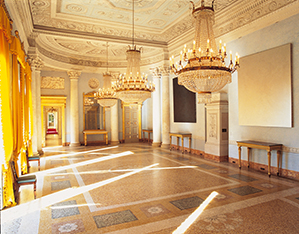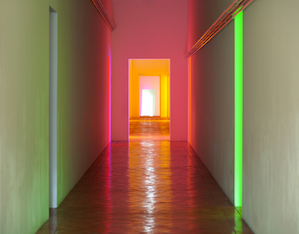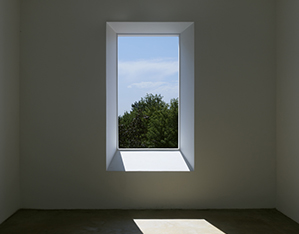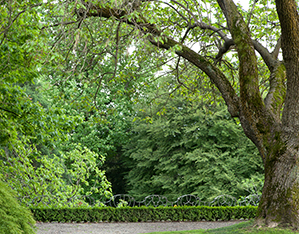At Villa Panza, the power of the genius loci is expressed through a kaleidoscope of creativity. Here, the tradition of the Italian garden and English parkland goes hand in hand with James Turrell’s dreamlike creations, framed by spaces ingeniously reworked by architects Piero Portaluppi and Gae Aulenti.
Initially built in the 18th century for Marquis Paolo Antonio Menafoglio, in the 1930s the villa was acquired by the Panza family. It has been under FAI ownership since 1996. The U-shaped villa and its elegant ground-floor portico provides the axis of symmetry for the park’s formal 18th-century portion. Enlarged by architect Luigi Canonica in the neoclassical period, the complex underwent further transformation in 1935, when Giuseppe Panza commissioned Piero Portaluppi to work on the 33,000 square metre park that looks out over the Prealps. The early 19th-century landscape, full of tall trees, including exotic and rare species, incorporates the ancient symmetries and romantic atmospheres of Italian gardens, featuring a small lake, a grotto and a hill dominated by a small temple. The gravel driveway leading up to the villa’s courtyard features eight grassy parterres and a fountain embellished with a pebble mosaic. A green hornbeam gallery welcomes visitors with evocative light effects, hosting one of the most significant Land Art pieces on the estate: A Tribute to the Carpinata Gallery, by British artist Stuart Ian Frost. A little further off is Fagus, an installation in which nature, geometry and human creativity intertwine in an interplay of mirrors made out of more than 30,000 beech blocks that takes in the whole park.
Highlights

The Villa and its Collections
Giuseppe Panza’s famous 2,500-item collection, assembled since the 1950s, is today distributed among a number of museums. The villa’s refined neoclassical rooms host more than a hundred works of contemporary American art (by Dan Flavin, Robert Irwin, Maria Nordman...), juxtaposed with African and pre-Columbian creations, and antique furnishings.

Contemporary Art in the Old Stables
Restored in 1996 by Gae Aulenti, the stables house site-specific installations by Robert Irwin, James Turrell, and Robert Wilson, as well as Dan Flavin’s luminous rooms. The works Skyspace I, Lunette and Virga (1974) investigate human perception by plunging viewers’ mind and body into an aura of light and colour.

Varese Window Room
Describing the Varese Window Room, a site-specific work created in 1973-76 by Robert Irwin (b. 1928), one of the greatest exponents of American Land Art, Giuseppe Panza commented: “The landscape looks as if it’s painted: the outside is brought inside. Seen like this, nature takes on an unusual intensity.” The Varese Window Room is a frameless window looking onto a large tree, its image different at every moment of the day and changing with the passing seasons.

Arboreal Heritage
Enriched by environmental art installations and with views out over the city, this centuries-old park boasts a remarkable collection of heritage trees. The most impressive specimens include a large strawberry tree (Arbutus unedo L.), which is on Italy’s list of monumental trees.
 Villa e Collezione Panza – FAI
Contacts
Villa e Collezione Panza – FAI
Contacts
Contacts
Telephone:+39 0332 283960
Address
Piazza Litta, 1
21100, Varese (VA)

FAI - Fondo Ambiente Italiano
 Villa e Collezione Panza – FAI
Opening times and prices
Villa e Collezione Panza – FAI
Opening times and prices
Opening hours
The villa is open all year round from Wednesday to Sunday, from 10 am to 6 pm.
Pricing
Entrance to the Villa and Park with free visit
- FAI members: free entrance
- Full price: € 12,00
- Reduced (6-18 years): € 5,00
- Students up to 25 years: € 8,00
- Family: € 30,00 (2 adults and 2 children. Starting from the third child, each entrance is free).
- Children under 5, National Trust members, Bienfaiteurs Amis du Louvre members, disabled people and accompanying person: free entry
Park entrance only
- FAI members: free entrance
- Full price: € 5,00
- Reduced (6-18 years): € 1,00
- Students up to 25 years: € 3,00
- Children under 5, National Trust members, Bienfaiteurs Amis du Louvre members, disabled people and accompanying person: free entry
Groups
Reduced rates for groups of at least 20 people
Guided tours
Guided tours of the permanent collection (Villa + Rustici) are available at the following rates:
- Guided tour in Italian language € 100
- Guided tour in a foreign language € 130
For all information on educational visits for schools, visit the FAI Scuola website.
 Villa e Collezione Panza – FAI
How to get there
Villa e Collezione Panza – FAI
How to get there
Address
Piazza Litta, 1
21100, Varese (VA)
Latitude: 45.8255027
Longitude: 8.8266673
How to arrive by road
Autostrada dei Laghi (A8) Milan-Varese motorway to Varese centre. Continue following the signs for the Villa.
How to arrive by train
Frequent trains from Milan, Como, Lugano and Malpensa Airport, get off at Varese Nord station, continue by bus line A (departing from Piazzale Trieste, in front of the state railway station), get off at the terminus.
The new Como – Varese – Malpensa rail link is worth mentioning.
- 20% discount on the entrance fee for holders of a valid ITINERO or IOVIAGGIO card.
- 10% discount on the entrance ticket for holders of an ordinary Trenord ticket validated on the same day of the visit to the location of the FAI Property served by Trenord rail transport. Specifically: Varese.
 Villa e Collezione Panza – FAI
Services/Accessibility
Villa e Collezione Panza – FAI
Services/Accessibility
Services
Dogs are only allowed in the park and always kept on a leash.
The Villa has an internal car park for cars for a fee (€ 3 per day). Free for FAI members.
Guided tours of the permanent collection (Villa + Rustici) are available at the following rates: Guided tour in Italian language € 100 Guided tour in a foreign language € 130 For all information on educational visits for schools, visit the FAI Scuola website.
Luce Restaurant For information and reservations, tel. +39 0332 242199 You can book the picnic basket at +39 0332242199 or [email protected] (reservations are accepted until the day before the visit)
An area with wi-fi is available for visitors.
In addition to the garden it is possible to visit the interior of the Villa. The residence took on a new destination when Count Giuseppe Panza, in the 1950s, began to create a collection of twentieth-century art, which over time became known throughout the world. More than 150 works by American artists (including Dan Flavin, James Turrel and Robert Irwin), inspired by the themes of light and colour, coexist in harmony with the ancient rooms, the Renaissance furnishings and the precious collections of African and pre-Columbian art.
Accessibility
- Disabled visitors have free access to FAI properties that are open to the public by presenting their ANMIC – Associazione Nazionale Mutilati e Invalidi Civili – membership card.
- Villa e Collezione Panza is accessible to visitors with hearing disabilities and to people with intellectual disabilities thanks to the “Sentire l’arte” and “Bene FAI per tutti” projects.
 Villa e Collezione Panza – FAI
Private events
Villa e Collezione Panza – FAI
Private events
At Villa Panza you can organize private events such as weddings, exclusive lunches and dinners, concerts, fashion shows and corporate events. The Villa is also the ideal setting for photo shoots and film sets.
For further information contact Simona Gasparini: tel. 0332 283960; [email protected]
 Villa e Collezione Panza – FAI
Itineraries
Villa e Collezione Panza – FAI
Itineraries
 Favorite saving result
Favorite saving result
 Warning!
Warning!
You've have to sign up or sign in to add this element to your favorites.
